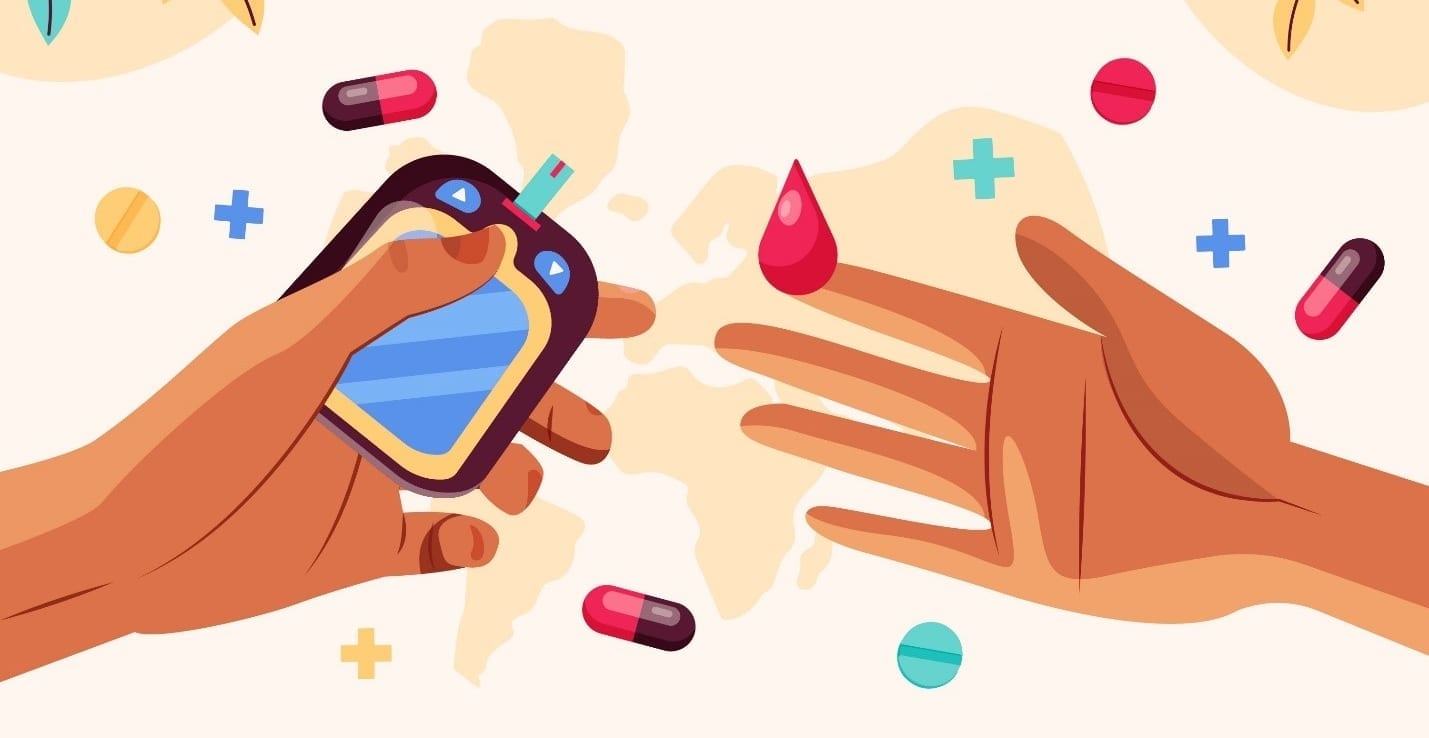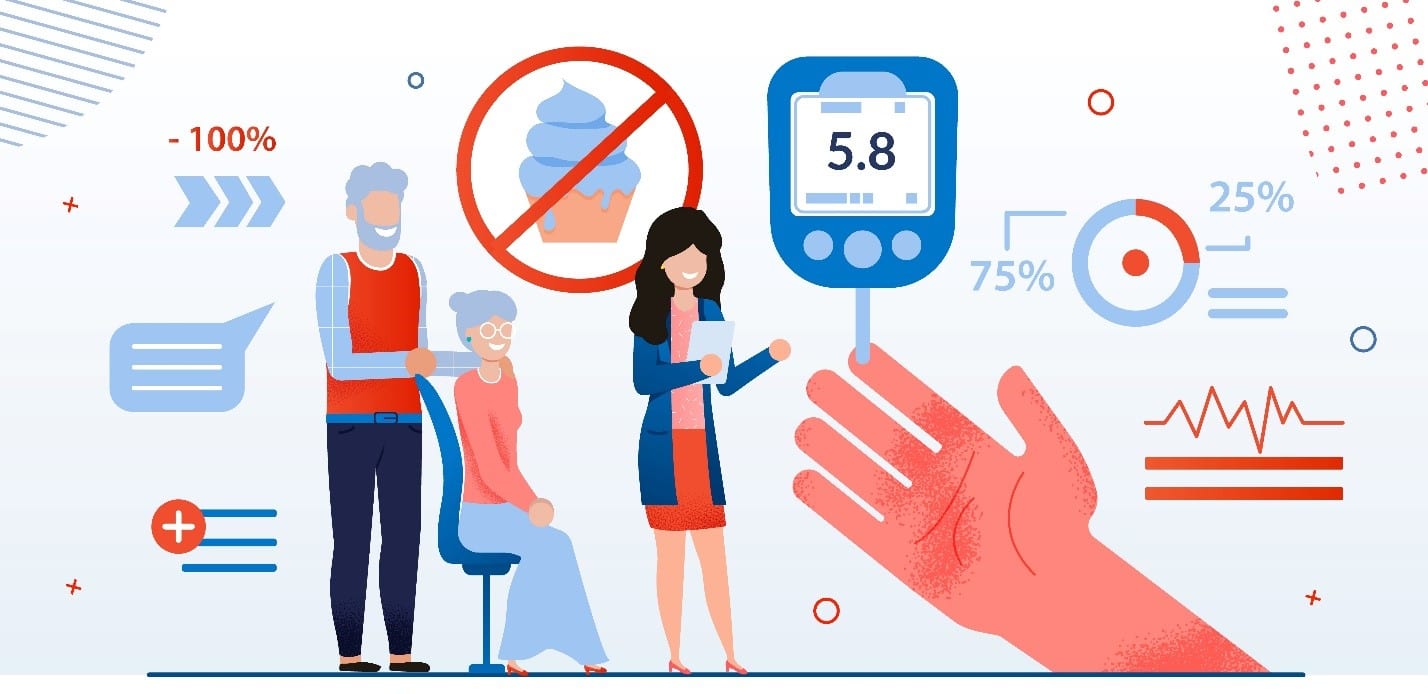
Diabetes, also known as the “silent killer,” is a disease that often lacks clear symptoms in its early stages. Patients typically only become aware of it when complications arise. Currently, the global prevalence of diabetes is noticeably on the rise, and it is affecting a younger demographic. Vietnam is among the countries experiencing one of the fastest-growing rates of diabetes in the world.
In response to the upcoming World Diabetes Day (14/11), Insmart sends customers and readers information related to diabetes including: causes of the disease, signs, treatment as well as measures to prevent and control diabetes to protect the health of yourself and your family.
Diabetes, also known as diabetes mellitus (DM), is a metabolic disorder characterized by higher blood sugar levels (more than 180 mg/dL) than normal (from 70mg/dL to less than 130mg/dL) due to insulin deficiency or resistance to insulin or both, leading to important disorders of sugar, protein, fat, mineral metabolism.
Diabetes is categorized into the following types:
Type 1 Diabetes (T1D) occurs when the beta cells of the pancreas are destroyed, leading to reduced or absent insulin secretion. As a result, there is very little insulin circulating in the blood, making it unable to regulate blood sugar levels. T1D is most commonly diagnosed in children and young individuals, typically under the age of 20.
Type 2 Diabetes (T2D) occurs when the body still produces insulin as in normal individuals but its effectiveness is reduced or insulin regulation is disrupted due to decreased beta cell function in the pancreas, often in the context of insulin resistance. T2D is more common in adults and is often linked to lifestyle factors.
Gestational Diabetes Mellitus (GDM) is diabetes diagnosed during the second or third trimester of pregnancy, with no prior evidence of type 1 or type 2 diabetes.

I. Causes of DM
To understand the causes of diabetes, you need to delve into the process of glucose metabolism in the body. Glucose is a type of sugar found in daily food intake and is stored in the liver as glycogen. When blood glucose levels drop, the liver breaks down glycogen molecules into glucose to balance blood sugar levels. This allows the blood to transport glucose to the cells for energy. However, cells cannot use this “fuel” directly and require the assistance of insulin, a hormone produced by the pancreas.
When there is an imbalance in the metabolic process, glucose cannot enter the cells to provide energy to the body, resulting in elevated blood sugar levels. Prolonged imbalances in this process lead to high blood sugar levels.

1. Causes of T1D
Although the exact causes are not yet conclusive, T1D may result from an autoimmune reaction that mistakenly attacks and destroys the beta cells of the pancreas responsible for insulin production. This leads to a lack of insulin or very little insulin in the body, resulting in increased glucose levels in the blood. Additionally, many patients with type 1 diabetes report a family history of the disease, suggesting a genetic predisposition. Environmental factors, exposure to certain viruses, can also contribute to the risk.
2. Causes of T2D
Approximately 85% of people with diabetes have type 2 diabetes. The exact causes of type 2 diabetes remain unclear, but genetics play a role in some cases. Additionally, being overweight or obese is closely associated with the disease.
Some risk factors that can lead to T2D include:
• Family history: If you have family members (parents, siblings, children) with diabetes, especially type 2 diabetes, your risk of developing the disease may increase due to genetic factors.
• Personal history of gestational diabetes: If you had gestational diabetes during a previous pregnancy, you have an increased risk of developing type 2 diabetes.
• Cardiovascular disease due to atherosclerosis: Atherosclerosis can limit blood flow and impair the body’s ability to supply insulin, increasing the risk of diabetes.
• High blood pressure: Elevated blood pressure, defined as a reading of 140/90 mmHg or higher, is a significant risk factor for diabetes.
• Lack of physical activity: Inactivity can lead to weight gain and disrupt blood sugar regulation as the pancreas must produce more insulin to transport glucose into cells, affecting glucose metabolism and energy production.
• Overweight or obesity: Excess body fat further contributes to insulin resistance.
• Impaired glucose tolerance or impaired fasting glucose: These are conditions where blood sugar levels are higher than normal but not yet in the diabetes range. Poorly controlled, over 50% of individuals with these conditions may progress to type 2 diabetes within 5-10 years.
• Polycystic ovary syndrome (PCOS) in women: This endocrine disorder may disrupt insulin sensitivity, increasing the risk of type 2 diabetes.
• Age: Anyone over the age of 40 is at increased risk of developing type 2 diabetes.
3. Causes of Gestational Diabetes
During pregnancy, the placenta produces hormones to sustain the pregnancy, and these hormones can reduce the body’s sensitivity to insulin. Additionally, the pancreas may not produce sufficient insulin to meet the increased demand, leading to reduced glucose transport into cells and elevated blood sugar levels, resulting in gestational diabetes.
Furthermore, during pregnancy, the body receives an increased supply of nutrients. However, the pancreas doesn’t always operate efficiently, failing to produce insulin in the right amounts and at the right times to meet the glucose metabolism needs. This can lead to the development of gestational diabetes.
Women who are overweight during pregnancy or experience excessive weight gain during pregnancy are also at a higher risk of developing gestational diabetes.

II. Early Signs and Symptoms of Diabetes
1. Symptoms of T1D
The symptoms of T1D typically progress rapidly and can appear within a few days or weeks, with characteristic manifestations including:
Feeling hungry and tired: After eating, the body converts food into glucose, which is the energy source for cells. However, when cells do not have enough insulin to absorb and convert glucose into energy, people with diabetes feel hungrier and more tired than usual.
Frequent thirst and urination: Typically, people without diabetes urinate 4-7 times in 24 hours, but those with diabetes may urinate more frequently. Normally, the body reabsorbs glucose as it passes through the kidneys. However, when blood glucose levels rise, the kidneys cannot reabsorb all of it, leading to increased urination. This, in turn, causes people with diabetes to urinate more often and feel constantly thirsty.
Dry mouth and itchy skin: Because the body is using fluid to produce urine, there is not enough moisture for other body parts. Dehydration can make the mouth feel dry, and dry skin can cause itching for people with diabetes.
Weight loss: Some individuals with diabetes may eat more but still lose weight over weeks due to water loss, fat breakdown, and muscle loss.
2.Symptoms of T2D
In T2D, symptoms progress quietly and develop over many years, with most patients not experiencing clear, noticeable signs:
Fungal infections: Both men and women with diabetes can develop fungal infections. Fungi thrive on glucose, so patients may experience infections in moist skin folds, between fingers, toes, in the under- breast area, or even in the genital area.
Slow-healing wounds: Prolonged high blood sugar levels can affect blood circulation and damage nerves, making it difficult for wounds to heal.
3. Symptoms of Gestational Diabetes
Pregnant women may experience increased thirst and more frequent urination than usual. The condition is typically diagnosed during the second or third trimester of pregnancy, often through a glucose tolerance test conducted at around 24-28 weeks of gestation.

III. Treatment Methods for People with Diabetes
Diabetes treatment needs to combine many factors including: lifestyle, eating, exercising, taking medications… to stabilize blood sugar levels. In addition, for each different type of diabetes, there will be specific treatment directions based on the patient’s health condition:
• In type 1 diabetes, patients are prescribed insulin for the rest of their lives because the body is no longer able to produce insulin on its own.
• In type 2 diabetes, patients can improve their hyperglycemia with daily nutrition and exercise or oral or injectable diabetes medications to stabilize blood sugar levels.
In order for the disease not to progress, patients with diabetes need to have a plan to monitor carbohydrate intake, as well as limit the use of processed, low-fiber foods; It is recommended to eat more greens, foods with a low glycemic index.
IV. Diabetes Prevention Measures

1. Weight Management
Controlling body weight through smart weight loss can reduce the risk of developing diabetes. The American Diabetes Association recommends that individuals with prediabetes (elevated blood sugar levels but not yet meeting the diagnosis for diabetes) aim to lose at least 7% to 10% of their body weight to prevent the disease from progressing.
2. Enhancing Physical Activity
Regular physical activity is beneficial not only for preventing diabetes but also for overall health:
• Physical activity aids in weight loss, reducing the risk of diabetes.
• Exercise helps lower blood sugar levels.
• It enhances insulin sensitivity, keeping blood sugar levels in check.
Engaging in activities like aerobic exercise, weightlifting, calisthenics, for a minimum of 30 minutes per day, 2 to 3 times a week, helps reduce the risk of diabetes.

3. Consuming Healthy Fruits and Vegetables
Whole grains and seeds provide vitamins, minerals, and low carbohydrate content. Foods with fewer sugars, starches (a source of energy for the body), and higher fiber content slow down the absorption of glucose and hinder the absorption of fat and cholesterol in the diet.
Examples of such foods include:
• Fruits like tomatoes, bell peppers, etc.
• Non-starchy vegetables like leafy greens, kale, and cauliflower.
• Legumes such as beans, chickpeas, and lentils.
• Whole grains like whole wheat bread, brown rice, oatmeal, and quinoa.
It’s also important for individuals at risk of diabetes to avoid foods high in sugars, low in nutrients, such as white bread, sugary drinks, and processed foods.
4. Incorporating Healthy Fats
To manage and control weight, the diet should include various sources of unsaturated fats, also known as “healthy fats.”
Unsaturated fats, especially Omega-3 fats from sources like fish, olive oil, sunflower oil, and various nuts, help regulate blood sugar, reduce bad cholesterol in the blood, and lower the risk of heart disease.

5. Say No to Smoking:
Smoking increases the risk of diabetes by 50% compared to non-smokers, especially in women. Therefore, individuals at risk of diabetes should quit smoking or avoid exposure to secondhand smoke to prevent the disease.
6. Regular Blood Sugar Monitoring:
Regular blood sugar monitoring, as advised by a doctor, ensures that blood sugar levels remain as close to the target range as possible. This helps prevent or delay complications related to diabetes.
Reference: tamanhhospital.vn, carepluvn.com & vinmec.com
V. INSMART HEALTH SCREENING PROGRAM ADMINISTRATION SERVICE

Insmart is a leading provider of corporate health screening program administration services in Vietnam. With the goal of ensuring the sustainability of the health of businesses and employees, we are committed to providing comprehensive services to support customers before, during, and after health check-ups, ensuring that customers receive attentive and thorough care throughout the service usage.
With over 12 years of experience working with medical providers and having a wide network of connections across many provinces and cities, Insmart has been providing professional, convenient, and superior health check program management and organization solutions. Through this service, we offer comprehensive health check programs to save manpower in the process of screening and consolidating medical costs, providing discounted prices for high-quality medical services at medical providers. This enhances the employee welfare program at your company.
Companies planning to organize regular health screening programs for their employees, please contact us via email at mkt@insmart.com.vn for detailed program organization advice.
Fanpage: https://www.facebook.com/insmartvn/
LinkedIn: www.linkedin.com/company/insmart-vietnam
Website: www.insmart.com.vn
[Marketing department – Insmart JSC]


